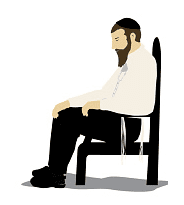ELLEN GELLER KAMARAS
“I strive to keep things light and positive. I look for beauty in everything and thrive on being active and in nature. My creative success is a gift.”
~~ Mimi ~~
You may have met Mimi when ordering custom invitations for an event or if you participated in one of her new wellness workshops.
Mimi was born and raised in Brooklyn and attended Bet Yaakov Ateret Torah from nursery through high school.
Her maternal grandparents are from Egypt and her father’s parents are from Argentina, both originally of Syrian descent.
A very serious student, Mimi enthusiastically participated in class. Although she adored her classmates, Mimi preferred reading books during recess.
Mimi had several outstanding role models.
Mimi’s father, Rabbi Yitzchak (Zacky), is a favorite first grade rebbe and has been at Ateret Torah since Mimi was born. “His students remember him for life. He also leaves an indelible mark on his overnight campers.”
Her dad has an incredible sense of humor and is positive and warm. Rabbi Zacky keeps things light and “loves interacting with people and makes them smile immediately.”
It’s no surprise that Mimi likes to “keep things light,” which she attributes to her father.
“My mom is a talented pianist and has been music director of many prominent schools. She has taught hundreds of private students, many of whom became piano teachers themselves.”
Mimi credits her mother for fostering her confidence, independence, and drive for self-improvement. “She didn’t coddle me. She always believed in me and my two sisters and encouraged me to work on solutions to problems, saying, ‘You can do it!’” Her mother’s advice is practical, proactive, and empowering.
Mimi is the oldest of three daughters and views her two sisters as her best friends. Mimi’s spirituality was nurtured by many, including school mentors and her maternal grandmother, Mrs. Sara Malka, and her maternal great grandmother. “My grandmother gives shiurim and is a rock, an inspiring source of faith and strength.” Mimi’s great grandmother, Adele Shwekey, a”h, passed away three years ago. Living close by, she was an extraordinary mentor who unconditionally loved Mimi and everyone she knew. “She believed in me and always pushed me to be better. I always left our visits on a high and invigorated. I miss her incredibly.”
Mimi is so appreciative for her large family and is very close to her many aunts, uncles, and cousins whom she loves and admires.
Career and Marriage
Mimi spent her gap year studying at B.Y.A. Seminary in Har Nof in Jerusalem. “It was an experience like no other. Meeting girls from all over, cultivating maturity and independence, being in a beautiful spiritual setting, and soaking up the learning.”
When she returned to NY, Mimi enrolled in a certificate program in computer graphics. Her first job was in Brooklyn at “Creative Expressions.” Mimi’s skillset grew as she worked on invitation layouts and calligraphy for bar mitzvahs and weddings and she designed flyers and other printed materials for three years. “I am forever grateful for that job opportunity.”
Around that time, Mimi met her husband Mordechai, through mutual cousins. “I was impressed with his positive outlook on life and his sterling middot. We became engaged after Sukkot.”
They have been married for 16 years and Mordechai spent fifteen of those years learning at the Shaare Zion Kollel in Brooklyn under Rabbi Yaacov Ben-Haim and Rabbi Yehuda Eliyahu. Five years ago, he started kiruv work at Congregation Ohr Torah in North Woodmere, saw immediate success, and recently accepted the Junior Rabbi position there.
The couple have six children, two daughters and four boys. The two oldest, who are girls, “are my right hands.” They are students at Ateret and Mimi enjoys experiencing Ateret again with her kids.
Mimi feels blessed to be a part of her community. There is an overall sense of belonging and people are always striving to grow and be there for each other.
Mimi’s Spark
My first impression of Mimi was that she was charming, poised, and grounded. Initially, I thought she was on the quiet side. When she began to talk about her passions, I saw her light up, and her liveliness and creative spark were palpable.
Mimi describes herself as an upbeat and positive person, aims to keep smiling, and has a colorful and creative mind.
In business, she is passionate about design, pattern, and color. In her daily routines and personal life, she seeks out beauty in nature, enjoys running and exercise, self-care, and balance. And of course, coffee dates with her cousins and friends. Mimi thrives on being active and has the most energy when she starts early. She is family-oriented and is very proud of her children.
“I like to keep things light and look for beauty in everything.”
On a Sunday, Mimi is often in Prospect Park or other scenic venues. She enjoys spending time outdoors whenever she can.
Mimi likes to change things up.
She is passionate about learning new things, is a big proponent of self-improvement, and reads books on health, motivation, self-help, and fashion and interior design.
Finding Balance
When Mimi was expecting her second child, she launched her own graphics business, “MimibyDesign,” working from home. She cultivated a client niche of schools and shuls and supported their graphic needs for Chinese auctions, fundraising, and more. Mimi helps small businesses with logos/ads and fulfilling assignments. Her large extended family kept her busy with invitations right from the start.
Running a business from home with young children wasn’t easy. “There were lots of challenges and time crunches. I took early phone calls from clients, met with clients during the day, picked up special orders, and worked late hours. I set boundaries for my work-life balance. All in all, the pros of working from home outweighed the cons.”
Mimi shared that it’s rewarding to see her finished products in print, and it brings her joy to participate in the planning of semahot and community events.
“My business grew organically through family and friends. My clients liked my easy-going attitude, my lightness when I would sit with the family, especially with both sides for wedding invitations. I was good with people, kept calm. Even if I feel stress, I avoid wearing it.”
The Pandemic Pivot
Covid hit and Mimi had many evites to prepare for semahot as they had become trendy.
After the pandemic, printing prices increased significantly. Mimi evaluated whether her clients would absorb the higher costs. The family spent the summer in Florida and Mimi took time to ponder the direction to take with her business. She also wanted to lose the residual weight from giving birth and devoured books she bought at Barnes & Noble on self-improvement, health, wellness, and clean eating. “I was hooked! Like most women, I’ve done typical diets but this resonated with me. I got into running, strength training, worked on my health, hired a personal trainer, and slimmed down. I sought to have positive energy and be in good physical shape so I could enjoy being active with my children.”
Mimi’s own journey to be healthy and fit provided her with essential tools that she wanted to share with others through her own wellness programs.
A talented hostess, cook, and advocate of clean eating, Mimi avoids processed foods like jarred sauces, mayonnaise, refined oils, white rice, sugar, and wheat.
She compiled an 80-page workbook on a metabolic reset, clean eating, and self-care. Her workbook is the basis for the six-session Whole-Heartedly Wellness Workshop that she developed for groups of women. Mimi served a gourmet lunch and healthy baked goods at her workshops and the attendees loved them. She then prepared a recipe booklet with her favorite healthy colorful meals.
Mimi’s clients urged her to sell her food. She decided on a lunch-to-go option so she wouldn’t be home cooking all day. LunchLab was born.
Mimi posts on her WhatsApp pictures of bright clean lunches available for sale and for clients to pick up the next morning. “I try new fun recipes with plant-based proteins, curries, veggie burgers, whole grain bowls, complex salads, delicious snacks sweetened with dates, coconut sugar, or raw maple syrup. Since we eat with our eyes, as a graphic designer, I ensure the bowls look tempting and are packaged attractively.”
Mimi is exhilarated about her venture into the wellness arena and looks forward to seeing where it will take her. She is considering getting certified in integrative health coaching. Mimi is also supporting her graphics client base.
“I enjoy teaching people how to love themselves, nurture their health with love and fun versus punishment or negative self-talk, practice self-care, adopt a growth mindset, and make food preparation fun and spectacular tasting. I post pictures of my recipes and outdoor excursions.
“I recommend behavior-based (BB) goals versus outcome based-goals (OB). Get fit to be healthy/vibrant versus losing ten pounds to fit into a dress for a party. BB goals become ingrained habits compared to OB goals which fizzle out if not met.”
Connect with Mimi at mimibydesign@gmail.com or at 718.431.4964 to join her WhatsApp status.
_____________________________________
Ellen Geller Kamaras, CPA/MBA, is an International Coach Federation (ICF) Associate Certified Coach. Her coaching specialties include life, career, and dating coaching. Ellen is active in her community and is currently the Vice-President of Congregation Bnai Avraham in Brooklyn Heights. She can be contacted at ellen@lifecoachellen.com(www.lifecoachellen.com).












